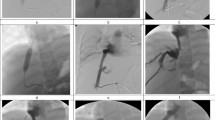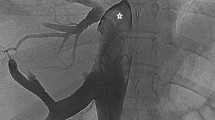Abstract
Purpose
To assess the usefulness of percutaneous transluminal angioplasty (PTA) and expandable metallic stent (EMS) placement for treatment of Budd-Chiari syndrome (BCS).
Methods
Thirty-two patients with BCS were treated by PTA alone or by PTA and EMS placement. Among the 32 patients, a membraneous obstruction was found in 24 and a segmental stenosis or occlusion in 8 patients. The follow-up period for PTA was 38–68 months (mean 52.2 months); for EMS it was 20–36 months (mean 24.3 months).
Results
Twenty-one patients underwent PTA as the primary treatment. Of these, one patient died of disseminated intravascular coagulation shortly after the procedure; 20 had good to excellent initial angiographic and clinical results. Of the 20, restenosis or reocclusion developed in 10 patients (48%), all before 27 months; 8 patients (38%) became symptomatic, and 2 remained symptom-free for a total recurrent obstruction rate of 50%. The EMS group of 17 patients included 11 patients who underwent primary stenting and 6 patients with secondary stenting after recurrence following primary PTA; restenosis was demonstrated in only 2 patients (12%).
Conclusions
We conclude that PTA alone produces excellent short-term results and about 50% sustained patency after 2 years in patients with BCS; therefore it should remain the procedure of first choice. Stents should be reserved for primary or secondary PTA failures.
Similar content being viewed by others
References
Xu K (1990) Bulloon angioplasty treatment for patients with Budd-Chiari syndrome. (in Japanese) Nippon Acta Radiol 50:1547–1557
Charnsangavej C, Carrasco CH, Wallace S, Wright KC, Ogawa K, Richli W, Gianturco C (1986) Stenosis of the vena cava: Preliminary assessment of treatment with expandable metallic stent. Radiology 161:295–298
Martin LG, Hendersen JM, Millikan WJ Jr, Casarella WJ, Kaufman SL (1990) Angioplasty for long-term treatment of patients with Budd-Chiari syndrome. AJR 154(5):1007–1010
Xu K, Wang CL, Zhang HG, He FX, Takahashi M, Kaneko M (1993) Preliminary study of Budd-Chiari syndrome treated with self-made intravascular stent: Report of 12 cases. Chin J Radiol 27:690–693
Xu K, Han MJ, Zhang HG, He FX, Zhang JR (1993) Clinical observation on Budd-Chiari syndrome treated by balloon angioplasty. Chin J Radiol 27:439–442
Hirooka M, Kimura C (1970) Membranous obstruction of the hepatic portion of the inferior vena cava. Arch Surg 100:656–663
Eguchi S, Takeuchi Y, Asano K (1974) Successful balloon membranotomy for obstruction of the inferior vena cava. Surgery 76:837–940
Yamada R, Sato M, Kawabata M, Nakatsuka H, Nakamura K, Kobayashi N (1983) Segmental obstruction of hepatic inferior vena cava treated by transluminal angioplasty. Radiology 149:91–96
Author information
Authors and Affiliations
Rights and permissions
About this article
Cite this article
Xu, K., He, FX., Zhang, Hg. et al. Budd-chiari syndrome caused by obstruction of the hepatic inferior vena cava: Immediate and 2-year treatment results of transluminal angioplasty and metallic stent placement. Cardiovasc Intervent Radiol 19, 32–36 (1996). https://doi.org/10.1007/BF02560144
Issue Date:
DOI: https://doi.org/10.1007/BF02560144




